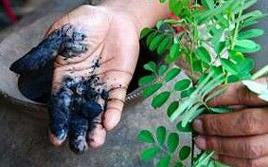Henna
There is a lot of discussion about managing consistent color results using henna for hair. Oodles of mixing ratios, methods and procedures abound when researching how to mix, cure and apply henna paste to the hair. A lot of other variables exist which affect absorption of color herb dyes, such as condition of hair, natural color of hair, gray hair, ethnic hair and types of herbal additives often used to adjust color shades. Basic concepts of henna assist you in deciding whether to use henna to color your hair. Firstly, henna cannot lighten your hair. If your hair is light blonde or gray, the red dye in the henna will produce a slight strawberry blonde to copper red depending on the length of time it remains on the hair. Thus the lighter the hair the more dramatic result. If you have light red to brown hair, naturally the henna will produce a deeper red color for natural red heads or red tone if your hair is brown. Black hair color is softened to a rich warm reddish hue.
Indigo
And if indigo is used alone on natural black hair, it will produce a slightly bluish hue. Clearly if you apply indigo to blond or gray hair you will get blue or greenish hair-not necessarily the most aesthetically pleasing result. The basic idea is that henna is the herbal hair dye which delivers color deepest into the hair shaft. Therefore henna is used as a vehicle for the other color herbs such as indigo to enter and “stick” in the hair without fading. For example, if you use indigo alone to produce a black or bluish hue to your natural dark brown or black hair color, the color from indigo fades or washes out immediately after rinsing no matter how long you leave the indigo preparation in the hair. Indigo always seems to work better mixed with henna or applied right after hair is henna-ed; basically when the henna stain is still fresh. This works because the indigo dye (blue) binds to the henna stain which allows for maintenance of the stain, the “adjusting “color indigo provides.
Cassia
Cassia obovata or simply Cassia is another herb often referred to as neutral “henna” or blonde “henna”. The source of these common names for cassia exist because chysophanic acid, in its pure form is yellow, and if it is in high concentrations in cassia, it may stain hair and skin yellow... thus it is often used and referred to as “blonde henna”. But it is not henna. Many people use Cassia to condition the hair, clean and disinfect the scalp or add to other color herbs for these purposes. Cassia with a high chysophanic acid or if mixed with rhubarb root with a chysophanic acid content can produce a tint of deeper yellow color to blonde or white/gray hair. Other natural colorants often mixed with henna include coffee, black tea, and black walnut.
Amla
Amla or Indian Gooseberry is another herb often used in hair care across the globe. The Amla plant produces a small astringent fruit, and the plant is processed into a powder to apply to hair to alleviate dandruff, an excessively oil producing scalp and other skin conditions which would benefit from an astringent agent resulting in more vibrant body and strength.


